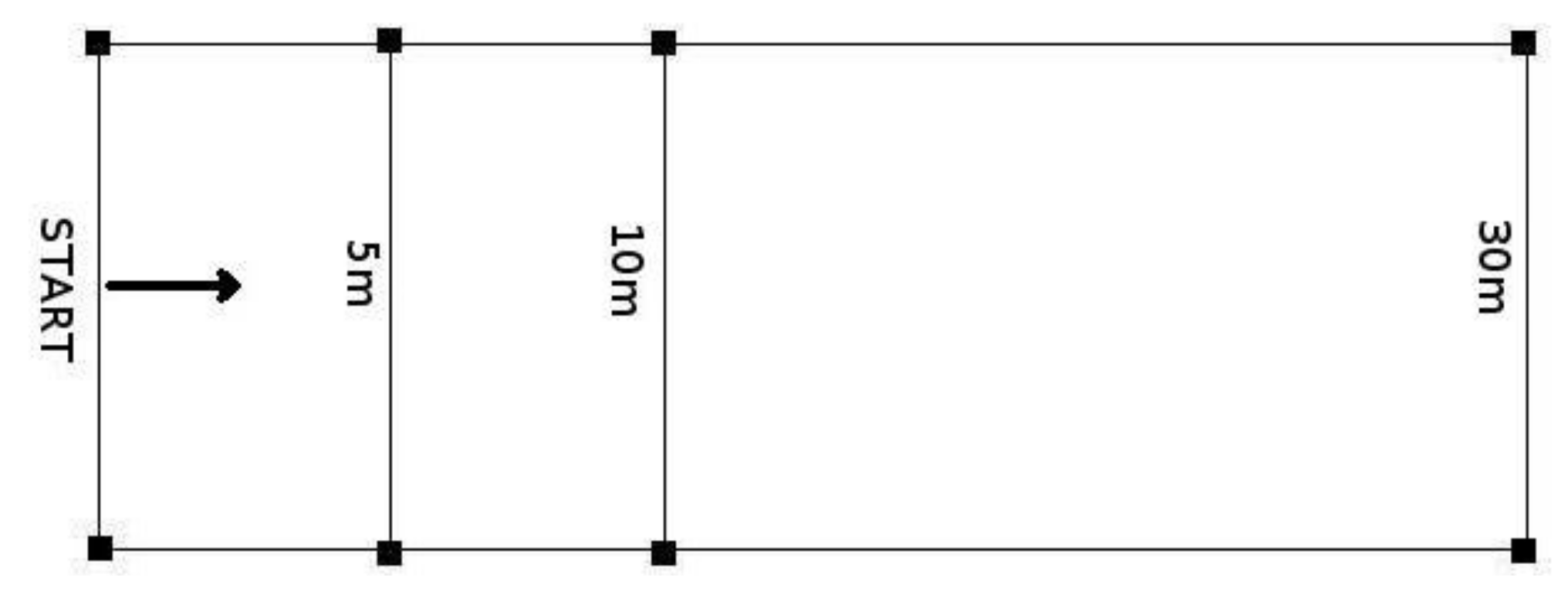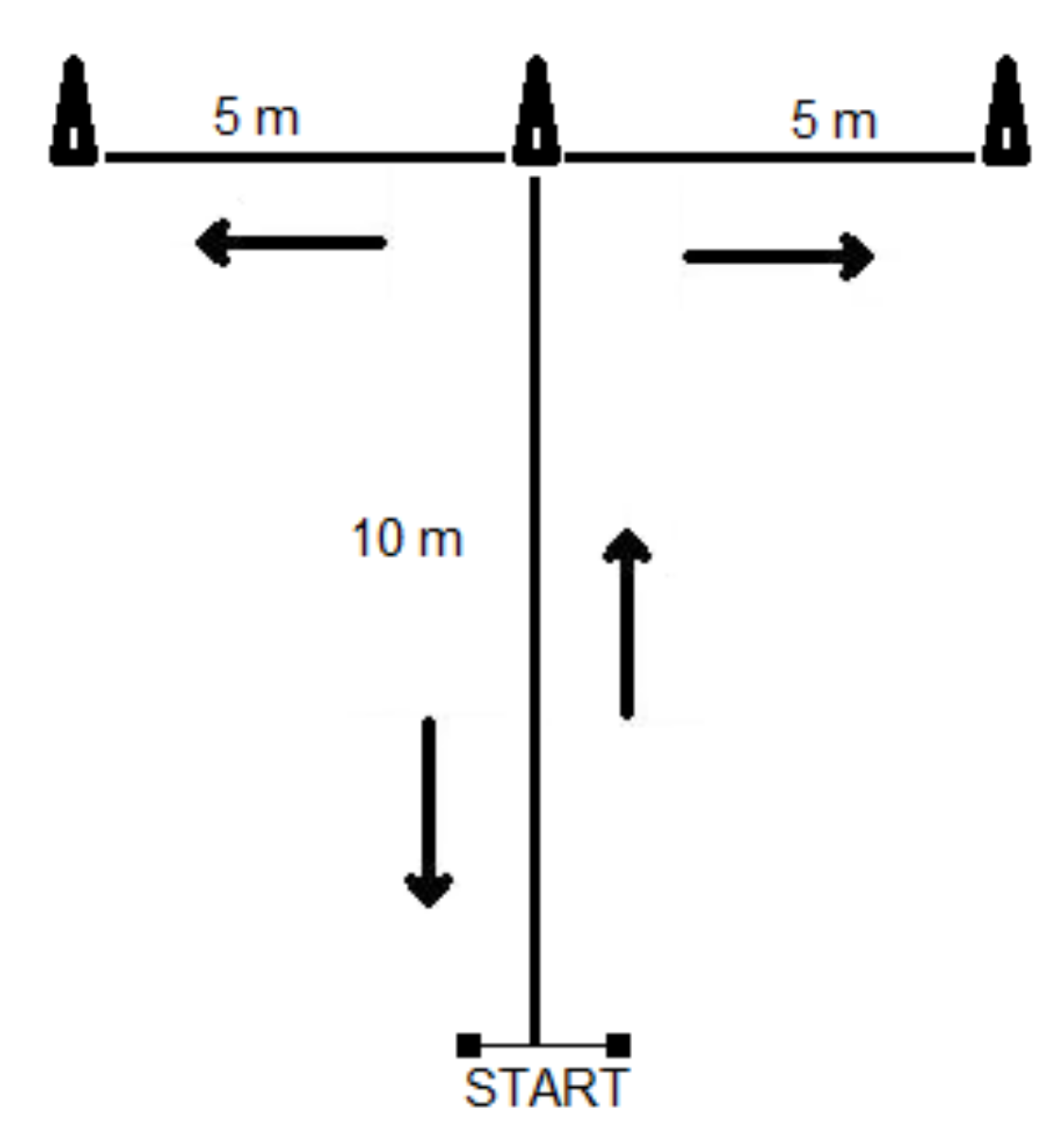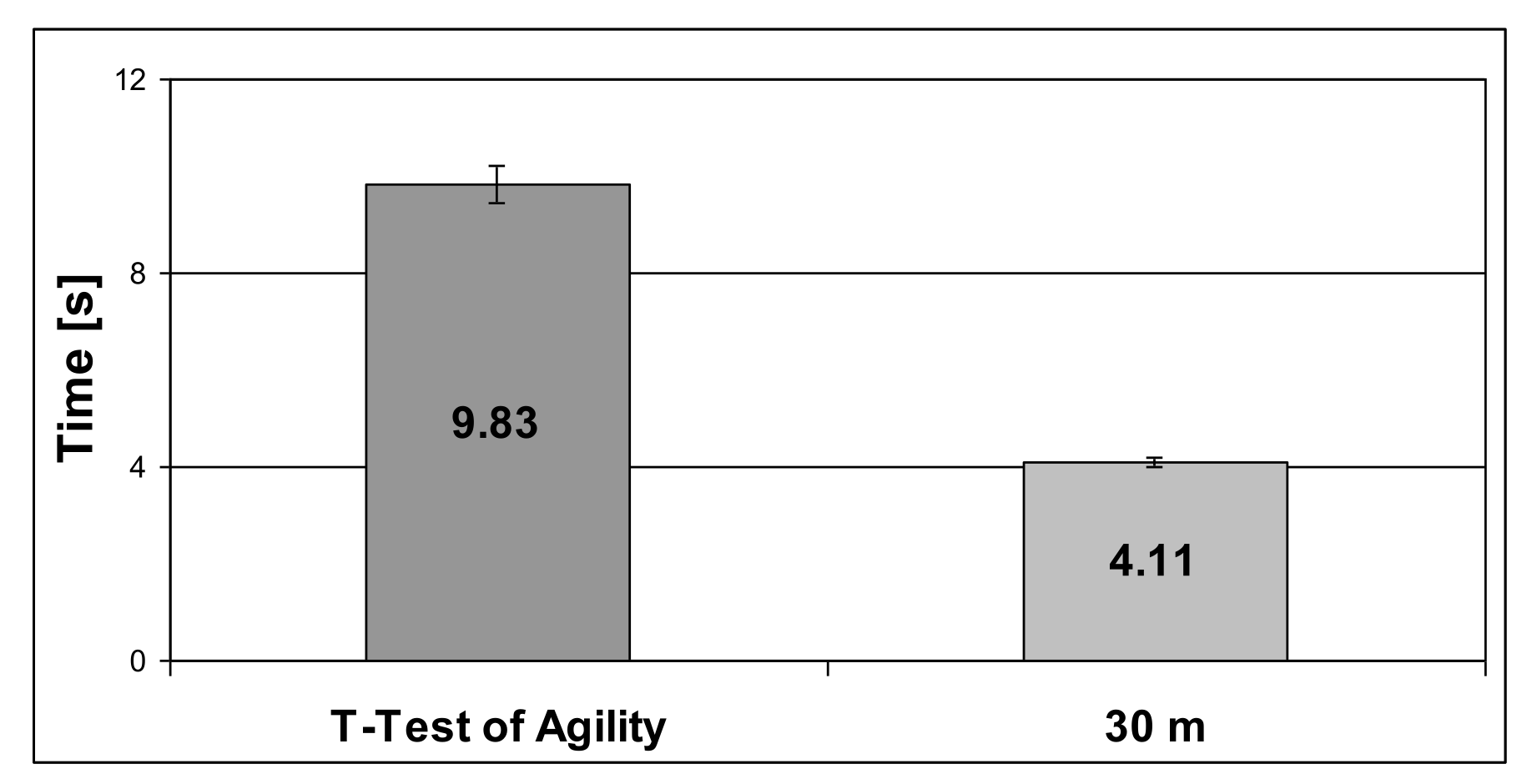Relationship between Isokinetic Knee Strength and Speed, Agility, and Explosive Power in Elite Soccer Players
Abstract
1. Introduction
2. Material and Methods
2.1. Study Design
2.2. Participants
2.3. Isokinetic Torque Measurement
2.4. Soccer Motor Ability Measurement
2.5. Statistical Analysis
3. Results
4. Discussion
5. Conclusions
Author Contributions
Funding
Institutional Review Board Statement
Informed Consent Statement
Data Availability Statement
Acknowledgments
Conflicts of Interest
References
- Bimson, L.; Langdown, L.; Fisher, J.P.; Steele, J. Six weeks of knee extensor isometric training improves soccer related skills in female soccer players. J. Tribol. 2017, 6, 52–56. [Google Scholar] [CrossRef]
- Meckel, Y.; Doron, O.; Eliakim, E.; Eliakim, A. Seasonal variations in physical fitness and performance indices of elite soccer players. Sports 2018, 6, 1–4. [Google Scholar] [CrossRef]
- Stepinski, M.; Ceylan, H.I.; Zwierko, T. Seasonal variation of speed, agility and power performance in elite female soccer players: Effect of functional fitness. Phys. Act. Rev. 2020, 8, 16–26. [Google Scholar] [CrossRef]
- Martinez-Lagunas, V.; Niessen, M.; Hartmann, U. Women’s football: Player characteristics and demands of the game. J. Sport Health Sci. 2014, 3, 258–272. [Google Scholar] [CrossRef]
- Manson, S.A.; Brughelli, M.; Harris, N.K. Physiological characteristics of international female soccer players. J. Strength Cond. Res. 2014, 28, 308–318. [Google Scholar] [CrossRef] [PubMed]
- Yılmaz, A.K.; Kabadayı, M.; Bostancı, Ö.; Özdal, M.; Mayda, M.H. Analysis of isokinetic knee strength in soccer players in terms of selected parameters. Phys. Educ. Stud. 2019, 23, 209–216. [Google Scholar] [CrossRef]
- Jovanovic, M.; Sporis, G.; Omrcen, D.; Fiorentini, F. Effects of speed, agility, quickness training method on power performance in elite soccer players. J. Strength Cond. Res. 2011, 25, 1285–1292. [Google Scholar] [CrossRef] [PubMed]
- Krustrup, P.; Zebis, M.; Jensen, J.M.; Mohr, M. Game induced fatigue patterns in elite female soccer. J. Strength Cond. Res. 2010, 24, 437–441. [Google Scholar] [CrossRef] [PubMed]
- Cometti, G.; Maffiuletti, N.A.; Pousson, M.; Chatard, J.C.; Maffulli, N. Isokinetic strength and anaerobic power of elite, subelite and amateur French soccer players. Int. J. Sports Med. 2001, 22, 45–51. [Google Scholar] [CrossRef]
- Lesinski, M.; Prieske, O.; Helm, N.; Granacher, U. Effects of soccer training on anthropometry, body composition, and physical fitness during a soccer season in female elite young athletes. Front. Physiol. 2017, 8, 1093. [Google Scholar] [CrossRef]
- Lehnert, M.; Stastny, P.; Tufano, J.J.; Stolfa, P. Changes in Isokinetic Muscle Strength in Adolescent Soccer Players after 10 Weeks of Pre-Season Training. Open Sports Sci. J. 2017, 10 (Suppl. S1), 27–36. [Google Scholar] [CrossRef]
- Sliwowski, R.; Grygorowicz, M.; Hojszyk, R.; Jadczak, L. The isokinetic strength profile of elite soccer players according to playing position. PLoS ONE 2017, 12, e0182177. [Google Scholar] [CrossRef] [PubMed]
- Aktuğ, Z.B.; Harbili, E.; Harbili, S. Comparison of isokinetic knee strength between the dominant and non-dominant legs and relationships among isokinetic strength, vertical jump, and speed performance in soccer players. Turk. Klin. J. Sports Sci. 2016, 8, 8–14. [Google Scholar] [CrossRef][Green Version]
- Eniseler, N.; Şahan, C.; Vurgun, H.; Mavi, H.F. Isokinetic strength responses to season-long training and competition in Turkish elite soccer players. J. Human Kinet. 2012, 31, 159–168. [Google Scholar] [CrossRef] [PubMed]
- Juneja, H.; Verma, S.K.; Khanna, G.L. Isometric strength and its relationship to dynamic performance: A systematic review. J. Exerc. Sci. Physiother. 2010, 6, 60–69. [Google Scholar]
- Anderson, M.A.; Gieck, J.H.; Perrin, D.; Weltman, A.; Rutt, A.R.; Denegar, C.R. The relationships among isometric, isotonic, and isokinetic concentric and eccentric quadriceps and hamstring force and three components of athletic performance. J. Orthop. Sports Phys. Ther. 1991, 14, 114–120. [Google Scholar] [CrossRef]
- Wrigley, T.W. Assessment for football: Soccer, Australian rules, and American. In Isokinetics in Human Performance; Brown, L.E., Ed.; Human Kinetics: Champaign, IL, USA, 2000; pp. 407–428. [Google Scholar]
- Trzaskoma, Z.; Wit, A.; Eliasz, J. Comparison of three laboratory tests of short duration with respect to the mechanical power output by lower limbs of athletes. Biol. Sport 1996, 13, 61–70. [Google Scholar]
- Tatlıcıoğlu, E.; Atalağ, O.; Kurt, C.; Acar, M.F. Investigation of the relationships between isokinetic leg strength, sprint and agility performance in collegiate American football players. Turk. J. Sports Med. 2020, 55, 192–199. [Google Scholar] [CrossRef]
- Rochcongar, P.; Morvan, R.; Dasonville, J.J.; Beillot, J. Isokinetic investigation of knee extensors and knee flexors in young French soccer players. Int. J. Sports Med. 1988, 9, 448–450. [Google Scholar] [CrossRef]
- Iosifidou, A.; Baltzopoulos, V.; Giakas, G. Isokinetic knee extension and vertical jumping: Are they related? J. Sports Sci. 2005, 23, 1121–1127. [Google Scholar] [CrossRef]
- Semenick, D. Tests and measurements: The T test. J. Strength Cond. Res. 1990, 12, 36–37. [Google Scholar] [CrossRef]
- Masuda, K.; Kikuhara, N.; Demura, S.; Katsuta, S.; Yamanaka, K. Relationship between muscle strength in various isokinetic movements and kick performance among soccer players. J. Sports Med. Phys. Fit. 2005, 45, 44–52. [Google Scholar]
- Aginsky, J.D.; Neophytou, N.; Charalambous, T. Isokinetic hamstring and quadriceps muscle strength profiles of elite South African football players. Afr. J. Phys. Health Educ. Recreat. Dance 2014, 20, 1225–1236. [Google Scholar]
- Rahnam, N.; Lees, A.; Bambaecichi, E. A comparison of muscle strength and flexibility between the preferred and nonpreferred leg in English soccer players. Ergonomics 2005, 48, 1568–1575. [Google Scholar] [CrossRef] [PubMed]
- Lehnert, M.; Svoboda, Z.; Cuberek, R. The correlation between isokinetic of knee extensors and vertical jump performance in adolescent soccer players in an annual training cycle. Acta Univ. Palacki. Olomuc. Gymn. 2013, 43, 7–15. [Google Scholar] [CrossRef]
- Naylor, J.; Greig, M. A hierarchical model of factors influencing a battery of agility tests. J. Sports Med. Phys. Fit. 2015, 55, 1329–1335. [Google Scholar]
- Oliver, J.; Meyers, R. Reliability and generality of measures of acceleration, planned agility, and reactive agility. Int. J. Sports Physiol. Perform. 2009, 4, 345–354. [Google Scholar] [CrossRef] [PubMed]
- Spiteri, T.; Nimphius, S.; Hart, N.H.; Specos, C.; Sheppard, J.M.; Newton, R.U. Contribution of strength characteristics to change of direction and agility performance in female basketball athletes. J. Strength Cond. Res. 2014, 28, 2415–2423. [Google Scholar] [CrossRef]
- Sheppard, J.M.; Dawes, J.J.; Jeffreys, I.; Spiteri, T.; Nimphius, S. Broadening the view of agility: A scientific review of the literature. J. Aus. Strength Cond. 2014, 22, 6–25. [Google Scholar]
- Coh, M.; Vodica, J.; Zvan, M.; Simenko, J.; Stodolka, J.; Rauter, S.; Mackala, K. Are change-of-direction speed and reactive agility independent skills even when using the same movement pattern? J. Strength Cond. Res. 2018, 32, 1929–1936. [Google Scholar] [CrossRef]
- Newman, M.A.; Tarpenning, K.M.; Marino, F.E. Relationships between isokinetic knee strength, single-sprint performance, and repeated-sprint ability in football players. J. Strength Cond. Res. 2004, 18, 867–872. [Google Scholar]
- Alemdaroğlu, U. The relationship between muscle strength, anaerobic performance, agility, sprint ability and vertical jump performance in professional basketball players. J. Human Kinet. 2012, 31, 149–158. [Google Scholar] [CrossRef] [PubMed]
- Sierer, S.P.; Battaglini, C.; Mihalik, J.P.; Shields, E.W.; Tomasini, N.T. The National Football League Combine: Performance differences between drafted and nondrafted players entering the 2004 and 2005 drafts. J. Strength Cond. Res. 2008, 22, 6–12. [Google Scholar] [CrossRef]
- Zakas, K.M.; Vamvakoudis, K.; Christoulas, E.; Aggelopoulou, N. Peak torque of quadriceps and hamstrings muscles in basketball and soccer players of different divisions. J. Sports Med. Phys. Fit. 1995, 35, 199–205. [Google Scholar]
- Kabacinski, J.; Murawa, M.; Mackala, K.; Dworak, L.B. Knee strength ratios in competitive female athletes. PLoS ONE 2018, 13, e0191077. [Google Scholar] [CrossRef] [PubMed]
- Çelenk, B.; Elif, Ö.Z.; Öner, A.G.; Elvan, Ö.Z. The relationship between isokinetic knee strength and jumping in young male volleyball players. Turk. J. Sport Exerc. 2019, 21, 12–15. [Google Scholar] [CrossRef][Green Version]
- Wilkosz, P.; Kabacinski, J.; Mackala, K.; Murawa, M.; John Ostarello, J.; Rzepnicka, A.; Szczesny, L.; Fryzowicz, A.; Maczynski, J.; Dworak, L.B. Isokinetic and isometric assessment of the knee Joint extensors and flexors of professional volleyball players. Int. J. Environ. Res. Public Health 2021, 18, 1–10. [Google Scholar]
- Gonzalez-Rave, J.M.; Juarez, D.; Rubio-Arias, J.A.; Clemente-Suarez, V.J.; Martinez-Valencia, M.A.; Abian-Vicen, J. Isokinetic leg strength and power in elite handball players. J. Human Kinet. 2014, 41, 227–233. [Google Scholar] [CrossRef] [PubMed]
- DeStaso, J.; Kaminski, T.W.; Perrin, D.H. Relationship between drop vertical jump heights and isokinetic measures utilizing the stretch-shortening cycle. Isokinet. Exerc. Sci. 1997, 6, 175–179. [Google Scholar] [CrossRef]
- Özcakar, L.; Kunduracyoğlu, B.; Cetin, A.; Ülkar, B.; Guner, R.; Hascelik, Z. Comprehensive isokinetic knee measurements and quadriceps tendon evaluations in footballers for assessing functional performance. Sports Med. 2003, 37, 507–510. [Google Scholar] [CrossRef]
- Tsiokanos, A.; Kellis, E.; Jamurtas, A.; Kellis, S. The relationship between jumping performance and isokinetic strength of hip and knee extensors and ankle plantar flexors. Isokinet. Exerc. Sci. 2002, 10, 107–115. [Google Scholar] [CrossRef]
- Anthrakidis, N.; Skoufas, D.; Lazaridis, S.; Zaggelidis, G. Relationship between Muscular Strength and Kicking Performance. Physical Training, October. Available online: http://ejmas.com/pt/2008pt/ptart_zaggelidis_0810.html (accessed on 22 October 2021).
- Cerrah, A.O.; Gungor, E.O.; Soylu, A.R.; Ertan, H.; Lees, A.; Bayrak, C. Muscular activation patterns during the soccer in-step kick. Isokinet. Exerc. Sci. 2011, 19, 181–190. [Google Scholar] [CrossRef]
- Blackburn, J.R.; Morrissey, M. The relationship between open and closed kinetic chain strength of the lower limb and jumping performance. J. Orthop. Sports Phys. Ther. 1998, 27, 430–435. [Google Scholar] [CrossRef]
- Kovaleski, J.E.; Heitman, R.J.; Andrew, D.P.; Gurchiek, L.R.; Pearsall, A.W. Relationship between closed-linear-kinetic- and open-kinetic-chain isokinetic strength and lower extremity functional performance. Acta Univ. Palacki. Olomuc. Gymn. 2013, 43, 196–204. [Google Scholar] [CrossRef][Green Version]
- Dauty, M.; Potiron, J. Correlations and differences of performance between soccer players, professionals, young players and amateurs, from the 10-meter sprint test and knee isokinetic assessment. Sci. Sport 2004, 19, 75–80. [Google Scholar] [CrossRef]
- Malliou, P.; Ispirlidis, I.; Beneka, A.; Taxildaris, K.; Godolias, G. Vertical jump and knee extensors isokinetic performance in professional soccer players related to the phase of the training period. Isokinet. Exerc. Sci. 2003, 11, 165–169. [Google Scholar] [CrossRef]
- Rodacki, A.L.; Fowler, N.; Bennett, S.J. Vertical jump co-ordination: Fatigue effects. Med. Sci. Sports Exerc. 2002, 34, 105–116. [Google Scholar] [CrossRef]
- Whiting, W.C.; Rugg, S. Dynatomy: Dynamic Human Anatomy; Human Kinetics: Champaign, IL, USA, 2006. [Google Scholar]
- Östenberg, A.; Roos, E.; Ekdahl, C.; Roos, H. Isokinetic knee extensor strength and functional performance in healthy female soccer players. Scand. J. Med. Sci. Sports 1998, 8, 257–264. [Google Scholar] [CrossRef]
- Brooks, K.A.; Clark, S.L.; Dawes, J.J. Isokinetic Strength and Performance in Collegiate Women’s Soccer. J. Nov. Physiother. 2013, 28 (Suppl. S3), 1–7. [Google Scholar]
- Malý, T.; Zahálka, F.; Malá, L.; Hráský, P.; Buzek, M.; Gryc, T. Relationships between isokinetic knee strength, sprint and jump performance in young elite soccer players. Footb. Sci. 2011, 8 (Suppl. S1), 237. [Google Scholar]




| Variable | 300°/s | 180°/s | 60°/s | p-Values (L vs. R) | ||||||
|---|---|---|---|---|---|---|---|---|---|---|
| L | R | L | R | L | R | 300°/s | 180°/s | 60°/s | ||
| Peak torque [N·m] | ||||||||||
| Extensors | 138.0 ± 16.9 | 132.8 ± 13.6 | 176.1 ± 15.9 | 172.0 ± 13.3 | 245.0 ± 26.9 | 250.1 ± 25.5 | 0.179 | 0.437 | 0.484 | |
| Flexors | 87.1 ± 14.3 | 89.0 ± 18.2 | 110.8 ± 15.6 | 113.5 ± 18.5 | 144.4 ± 19.0 | 151.9 ± 29.0 | 0.679 | 0.382 | 0.478 | |
| Time to peak torque [ms] | ||||||||||
| Extensors | 141.9 ± 16.6 | 139.5 ± 20.4 | 203.8 ± 43.7 | 200.0 ± 39.1 | 491.0 ± 147.1 | 513.3 ± 109.4 | 0.692 | 0.768 | 0.368 | |
| Flexors | 153.3 ± 27.4 | 164.3 ± 51.2 | 204.3 ± 45.3 | 201.0 ± 49.8 | 322.4 ± 87.8 | 384.3 ± 123.4 | 0.523 | 0.922 | 0.006 * | |
| Average power [W] | ||||||||||
| Extensors | 276.9 ± 41.6 | 266.2 ± 36.0 | 284.6 ± 29.5 | 275.9 ± 31.2 | 165.0 ± 21.6 | 169.9 ± 15.6 | 0.195 | 0.493 | 0.280 | |
| Flexors | 165.6 ± 38.3 | 161.6 ± 44.1 | 178.7 ± 30.8 | 182.9 ± 32.9 | 100.0 ± 17.2 | 105.6 ± 14.7 | 0.597 | 0.597 | 0.111 | |
| Variable. | Peak Torque | Time to Peak Torque | Average Power | Time | |||||||
|---|---|---|---|---|---|---|---|---|---|---|---|
| 300°/s | 180°/s | 60°/s | 300°/s | 180°/s | 60°/s | 300°/s | 180°/s | 60°/s | T-Test of Agility | 30 m | |
| Jump height for SJ | 0.170 | 0.166 | −0.061 | 0.202 | −0.057 | 0.016 | 0.058 | 0.182 | −0.155 | −0.146 | −0.473 * |
| Jump height for CMJ | 0.222 | 0.249 | −0.109 | 0.225 | −0.169 | −0.154 | 0.074 | 0.062 | −0.109 | −0.009 | −0.399 |
| Maximal power for SJ | 0.103 | 0.269 | 0.263 | 0.215 | −0.128 | 0.263 | 0.060 | 0.153 | 0.125 | 0.268 | −0.368 |
| Maximal power for CMJ | 0.267 | 0.474 * | 0.335 | 0.051 | 0.080 | 0.034 | 0.175 | 0.370 | 0.335 | 0.202 | −0.321 |
| Variable | Peak Torque | Time to Peak Torque | Average Power | ||||||
|---|---|---|---|---|---|---|---|---|---|
| 300°/s | 180°/s | 60°/s | 300°/s | 180°/s | 60°/s | 300°/s | 180°/s | 60°/s | |
| Extensors | |||||||||
| T-test agility time | 0.345 | 0.325 | 0.205 | −0.177 | −0.275 | −0.144 | 0.303 | 0.037 | 0.030 |
| 30 m time | −0.204 | −0.133 | 0.044 | −0.213 | −0.113 | −0.315 | −0.235 | −0.243 | 0.003 |
| Flexors | |||||||||
| T-test agility time | 0.513 * | 0.404 | 0.557 * | −0.171 | −0.202 | 0.090 | 0.414 | 0.142 | 0.112 |
| 30 m time | 0.069 | 0.033 | −0.104 | 0.154 | 0.003 | −0.254 | −0.021 | −0.180 | −0.023 |
Publisher’s Note: MDPI stays neutral with regard to jurisdictional claims in published maps and institutional affiliations. |
© 2022 by the authors. Licensee MDPI, Basel, Switzerland. This article is an open access article distributed under the terms and conditions of the Creative Commons Attribution (CC BY) license (https://creativecommons.org/licenses/by/4.0/).
Share and Cite
Kabacinski, J.; Szozda, P.M.; Mackala, K.; Murawa, M.; Rzepnicka, A.; Szewczyk, P.; Dworak, L.B. Relationship between Isokinetic Knee Strength and Speed, Agility, and Explosive Power in Elite Soccer Players. Int. J. Environ. Res. Public Health 2022, 19, 671. https://doi.org/10.3390/ijerph19020671
Kabacinski J, Szozda PM, Mackala K, Murawa M, Rzepnicka A, Szewczyk P, Dworak LB. Relationship between Isokinetic Knee Strength and Speed, Agility, and Explosive Power in Elite Soccer Players. International Journal of Environmental Research and Public Health. 2022; 19(2):671. https://doi.org/10.3390/ijerph19020671
Chicago/Turabian StyleKabacinski, Jaroslaw, Piotr M. Szozda, Krzysztof Mackala, Michal Murawa, Agata Rzepnicka, Piotr Szewczyk, and Lechoslaw B. Dworak. 2022. "Relationship between Isokinetic Knee Strength and Speed, Agility, and Explosive Power in Elite Soccer Players" International Journal of Environmental Research and Public Health 19, no. 2: 671. https://doi.org/10.3390/ijerph19020671
APA StyleKabacinski, J., Szozda, P. M., Mackala, K., Murawa, M., Rzepnicka, A., Szewczyk, P., & Dworak, L. B. (2022). Relationship between Isokinetic Knee Strength and Speed, Agility, and Explosive Power in Elite Soccer Players. International Journal of Environmental Research and Public Health, 19(2), 671. https://doi.org/10.3390/ijerph19020671







